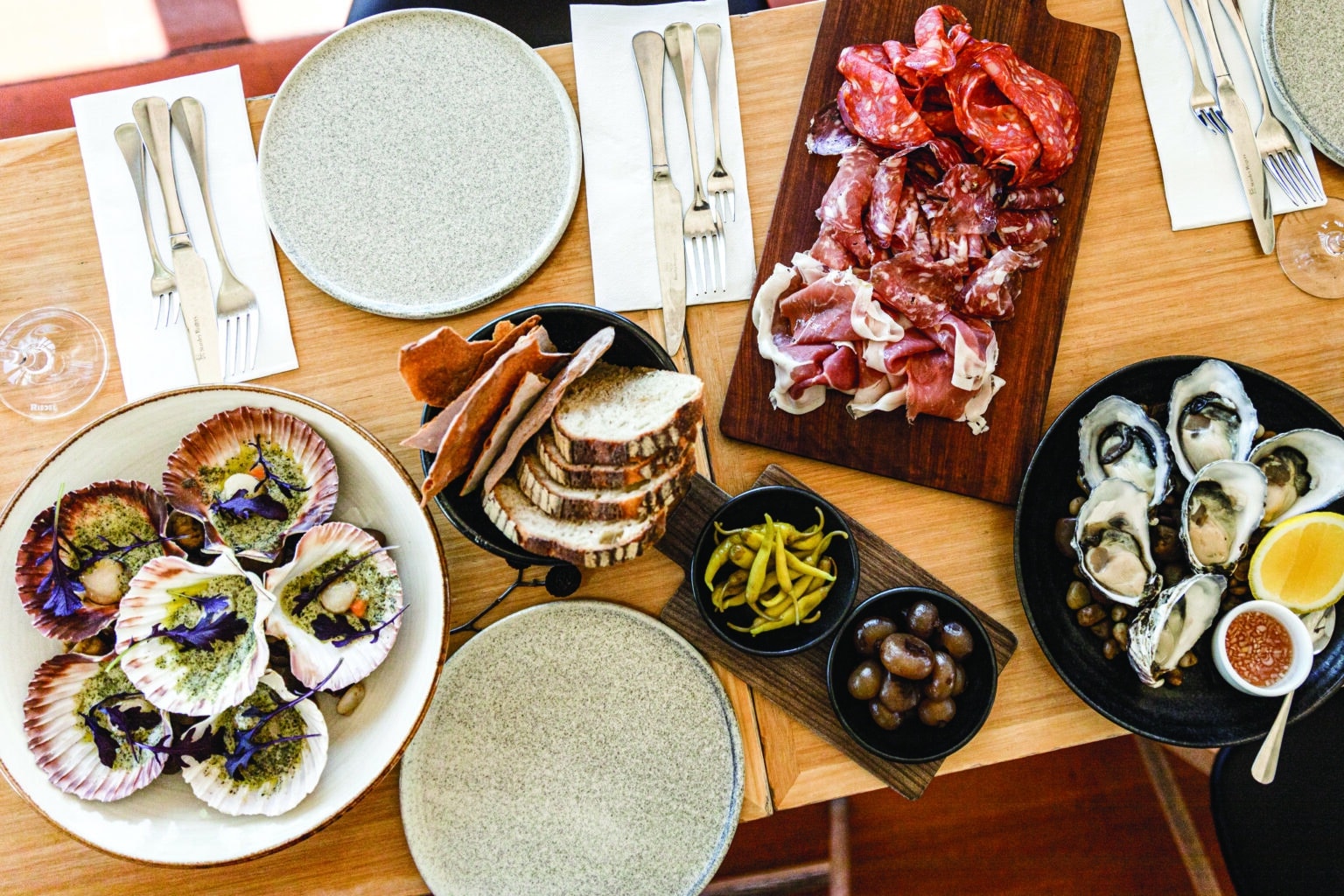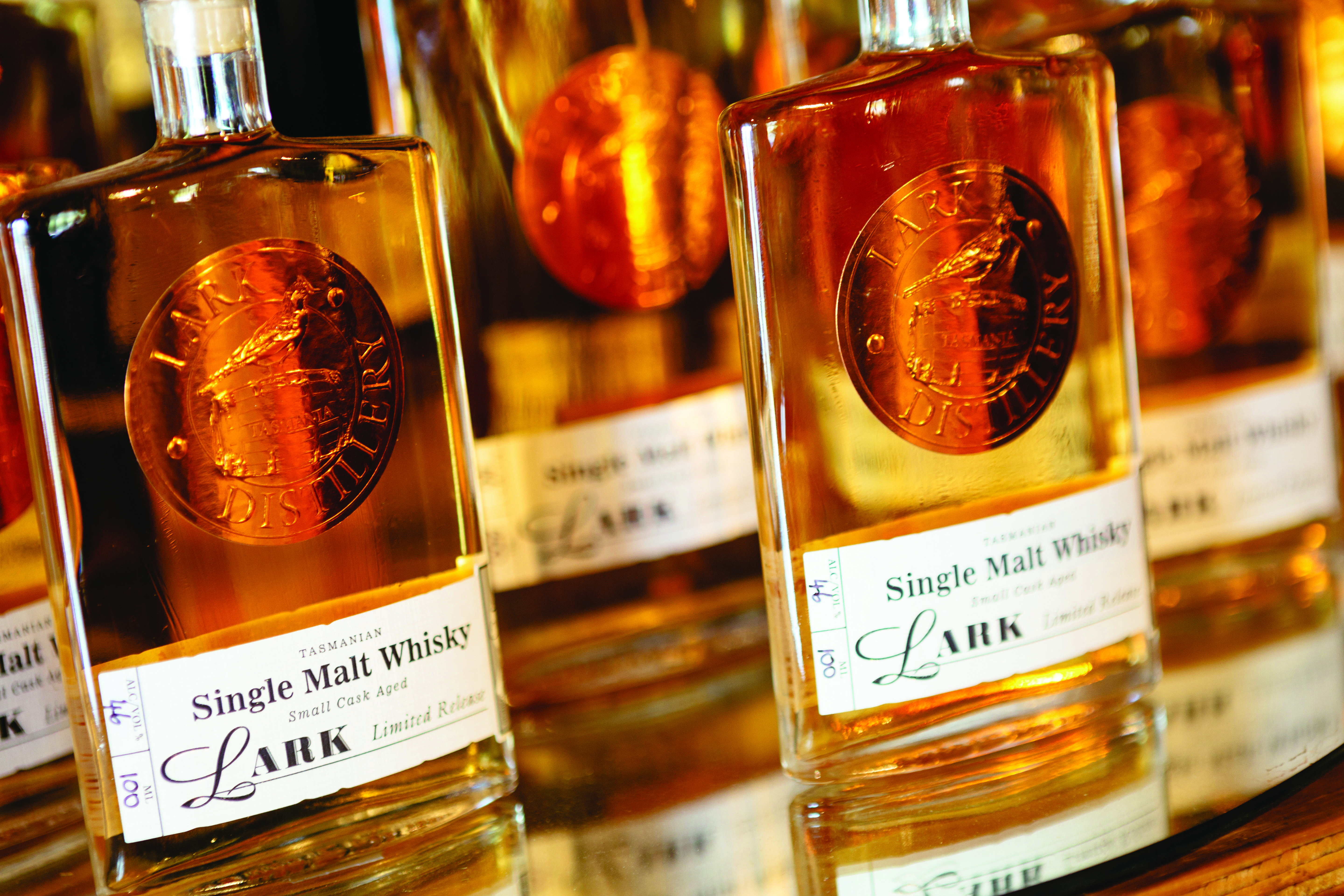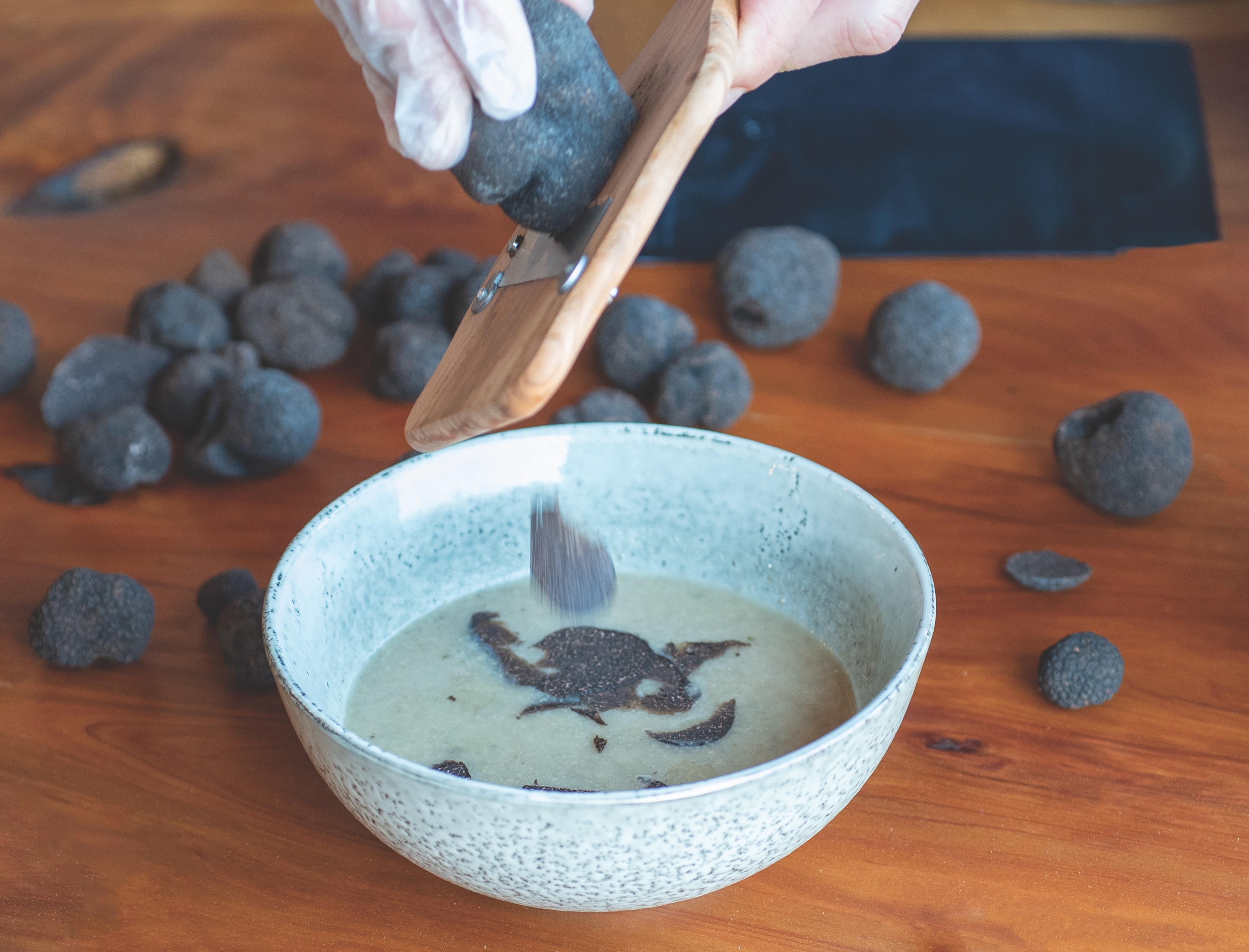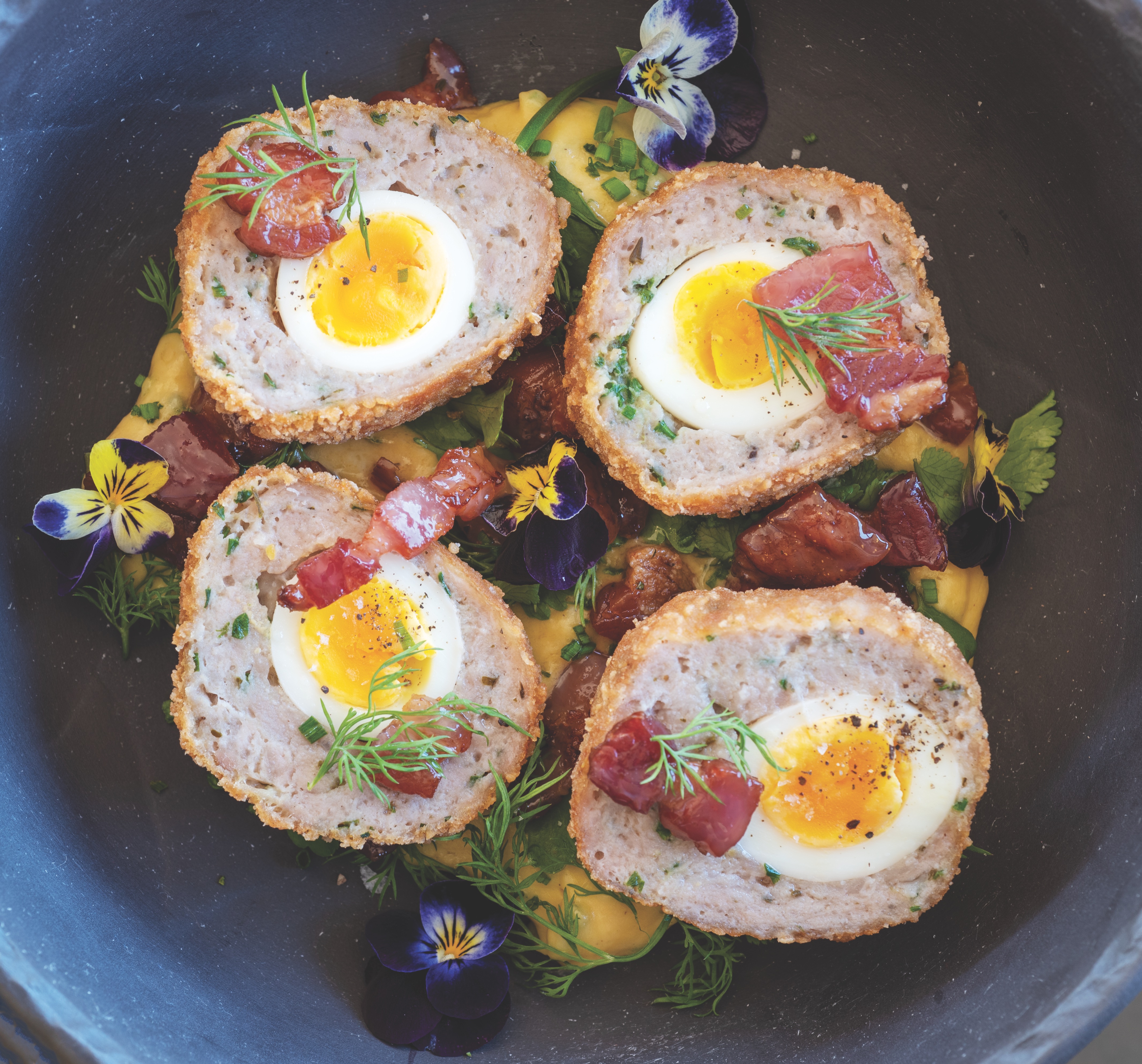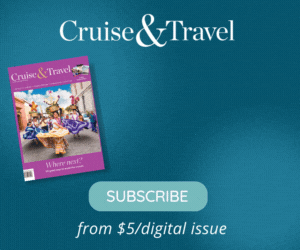For a state that makes up less than one per cent of Australia’s land mass, Tasmania sure packs a punch when it comes to epicurean experiences.
From the pristine waters of a coastline brimming with deep-sea fish, abalone, oysters and even sea urchins to fertile valleys filled with farm gates and cellar doors, you could happily spend weeks here drifting from one welcoming restaurant to the next, dining on sensational fare created by innovative chefs tapping into close-knit communities of local growers, farmers and fishermen.
With most flights landing in Hobart, the Tasmanian capital is a great place to start your gourmet adventure. The pioneering Hobart destination restaurant Franklin may have closed its doors in 2020, but there are still plenty of amazing dining options to choose from in the compact city centre.
First, though, check into a centrally located hotel like MACq 01, where each suite tells the tale of a famous, or notorious, Tasmanian. This unique ‘storytelling hotel’ is right on the waterfront facing Constitution Dock, and my spacious room has wall-to-ceiling glass doors and a balcony taking full advantage of the water views. I’ve also enjoyed staying at the nearby boutique Moss hotel, which offers a series of cosy, well-appointed suites straddling a handsome old sandstone warehouse and a historic pub in Salamanca Place.
If you opt for MACq 01, you needn’t travel far for your first meal: the in-house Old Wharf Restaurant, led by Simon Pockran, a former head chef at uber-luxe Tasmanian resort Saffire, reimagines and refines traditional family dishes. (It’s also where you’ll take breakfast in the morning.) Across the road from MACq 01, at its sister hotel The Henry Jones, culinary curator Ben Milbourne scours the state for the finest produce to feature on the seasonal menus at Peacock and Jones.
Away from Constitution Dock, Dier Makr offers elaborate tasting menus bursting with flavour in a tiny space a short walk from the water – note that you need to book well ahead, and it’s only open Thursday to Saturday. Oh, and the name is pronounced like a heavily slurred ‘Jamaica’. There’s a paired wine option and an eclectic wine list – the night I dined here we had an unfiltered mtsvane from the former Soviet republic of Georgia.
Around a 20-minute walk, or a five-minute drive, from Constitution Dock, popular ‘neighbourhood restaurant’ Templo plates up a weekly seasonal chef’s menu of Mediterranean-influenced, richly flavoured dishes and pairs them with minimal-intervention Italian-varietal wines. It’s a small dining room and it’s also one of the few restaurants in town open on a Monday night, but while it’s busy the night I eat here, the dishes appear with impressive regularity.
For a long lunch with excellent biodynamic wines, head to Osteria Vista, at Stefano Lubiana Wines, a 25-minute drive from the city centre in the Derwent Valley, past Mona. Here you can enjoy a leisurely Italian-inspired four-course degustation lunch from Friday to Sunday. Otherwise you could opt for the light Italian lunch fare at Cibo e Vino cafe at Battery Point, on the high ground above Salamanca Place.
Australia’s most awarded whisky is distilled in Hobart: Sullivans Cove has picked up multiple gongs at the World Whiskies Awards for its divine single malts. Taste flights of whiskies and take a tour of its distillery at Cambridge, between the airport and the city centre. The distillery and tasting room are in a warehouse in an unprepossessing industrial estate, but what happens inside is magic. Prefer to have a tipple in town? Tasmanian single-malt whisky pioneer Lark Distillery’s tasting room has a prime position on the Hobart waterfront at Constitution Dock. You can also take your pick of around 150 Tasmanian whiskies to try at The Still, Lark’s new whisky and cocktail bar a couple of blocks back from the waterfront.
An essential stop on any Tasmanian gourmet road trip is Rodney Dunn and Séverine Demanet’s Agrarian Kitchen Eatery in New Norfolk, a 40-minute drive from Hobart. Here we dine on expertly prepared dishes featuring local seasonal produce in a high-ceilinged space in the grounds of a former mental asylum. From April, the relocated Agrarian Cooking School & Kitchen Garden will commence a program of cooking classes on site, including two-day Whole Hog nose-to-tail experiences, if you want to immerse in hyper-local cuisine.
From New Norfolk it’s around a two-and-a-half-hour drive to Launceston, Tasmania’s second largest city and the perfect base for exploring the surrounding food bowl and wineries of the Tamar Valley. The foodie’s stay of choice is Stillwater Seven, housed in a former flour mill at the mouth of Cataract Gorge. The seven suites here face out to the Tamar River and feature massive exposed timber beams and lashings of green velvet. I was tempted to raid the impressive mini-bar and sink into the massive bed in my room, but instead took the door leading down to Stillwater, Launceston’s most awarded fine-dining experience, for a memorable meal overlooking the river.
A 10-minute stroll from Stillwater Seven takes you to Launceston’s walkable shopping and dining precinct. Here you’ll find plenty of great options for breakfast or lunch, including Bread + Butter, a bakery, cafe and butter factory rolled into one. Sample a range of Tasmanian craft brews at Saint John Craft Beer, also in the city centre, before dinner at nearby Pachinko, which serves up sustainably farmed, organic and ethically produced modern Asian fare. Come in the colder months, like I did, and you may have a hankering for a big steak and a glass of red at Black Cow Bistro, Stillwater’s sister restaurant in town, which perfectly grills dry-aged Cape Grim and Robbins Island beef.
After you’ve eaten your way around Launceston, it’s time for foodie forays out of town. A 50-minute drive west of the city brings you to The Truffle Farm in Deloraine, the first of its kind in Australia. I join Mandy, a border collie-kelpie cross, as she sniffs out black truffles in the farm’s hazelnut tree groves, then watch the fragrant, earthy nuggets graded on site. We then get to sample the previous days’ haul shaved over a rich mushroom soup – sublime. You can book a truffle hunt with optional lunch from December to September each year, and there’s a farm-gate shop where can pick up sealed packs of truffles and truffle butter to take home.
Heading north from Launceston, you’ll hit wine country in less than 15 minutes – the first cellar door you’ll encounter is Vélo Wines, which focuses on French varietals. The Tamar Valley cool-climate wine region is best known for pinot noir and chardonnay, sauvignon blanc, pinot gris and riesling, with more than 30 wineries in the area.
Standout wineries on the road from Launceston, along the western side of the river, to the coast include Moores Hill Estate, which produces fine pinot noir, chardonnay and riesling at Tasmania’s first solar-powered winery, and Stoney Rise, where you can sample minimal-intervention wines in a striking cellar door complex.
Then there’s Tamar Ridge, where the winemakers are on a mission to produce “elegant and exciting” pinot noir – try their efforts for yourself at the winery’s cellar door, which is just up the road from Vélo. If you time your visit well, you can enjoy Danielle Lefrancois’s delicious contemporary-French-influenced fare at her Hubert + Dan restaurant at Tamar Ridge for lunch each weekend and dinner every second Thursday night.
The Tamar Valley is also known for its world-class sparkling wines. Take Batman Bridge over the Tamar River to the Pipers River sub-region to check out the fruits of terroir that’s remarkably similar to the French region of Champagne. Arrange a summertime visit to Tamar Valley pioneer Andrew Pirie’s Apogee cellar door to taste his exceptional single-vineyard sparkling wines, or head to nearby Clover Hill for a tasting of six of the award-winning house’s elegant bubblies. Clover Hill’s cellar door looks out over the eastern side of Tamar Valley – so while you work your way through the six pours you can plan out the next stop on your journey of discovery.
Concierge
When to go
With COVID causing so much disruption, the question of when to go now has two parts: what time of the year, and which part of the week. While the pandemic end-game plays out, you’ll find most city and regional eateries closed on Monday and Tuesday, with many shuttered on Sunday or Wednesday too. So if you want to eat your way around the state, plan on having slim pickings in the first half of the week. As for the time of year, the mild summer months are ideal, but can also be quite busy. Winters here are chilly but also host a number of food and drink festivals, such as Dark MoFo’s winter feast in June, and Tasmanian Whisky Week and Bridport’s Tassie Scallop Fiesta in August.
What to pack
Whatever time of the year you visit Tasmania, stick a jumper and a rain jacket in your suitcase, especially if you’re heading over to the west coast, which is said to be one of the wettest places in the world. The eastern side of Tasmania escapes much of the west’s deluges, and Hobart is actually the second-driest state capital, after Adelaide. In winter, dress in layers, for while early mornings and evenings will be frosty, the sun can still be strong in the middle of the day. And all year round, dress in smart casual gear to blend in with the locals
at upmarket restaurants.
Most memorable meal
With black truffles costing more than $2,000 a kilogram, you usually only get a few slivers in restaurant dishes purportedly featuring this precious ingredient. But dine at Launceston’s Stillwater in the winter months and you can enjoy multiple courses of truffle-heavy delights created by executive chef Craig Will and paired with fine Tasmanian wines. Even the dessert arrives redolent of the earthy fungus, an unlikely but winning combination.

